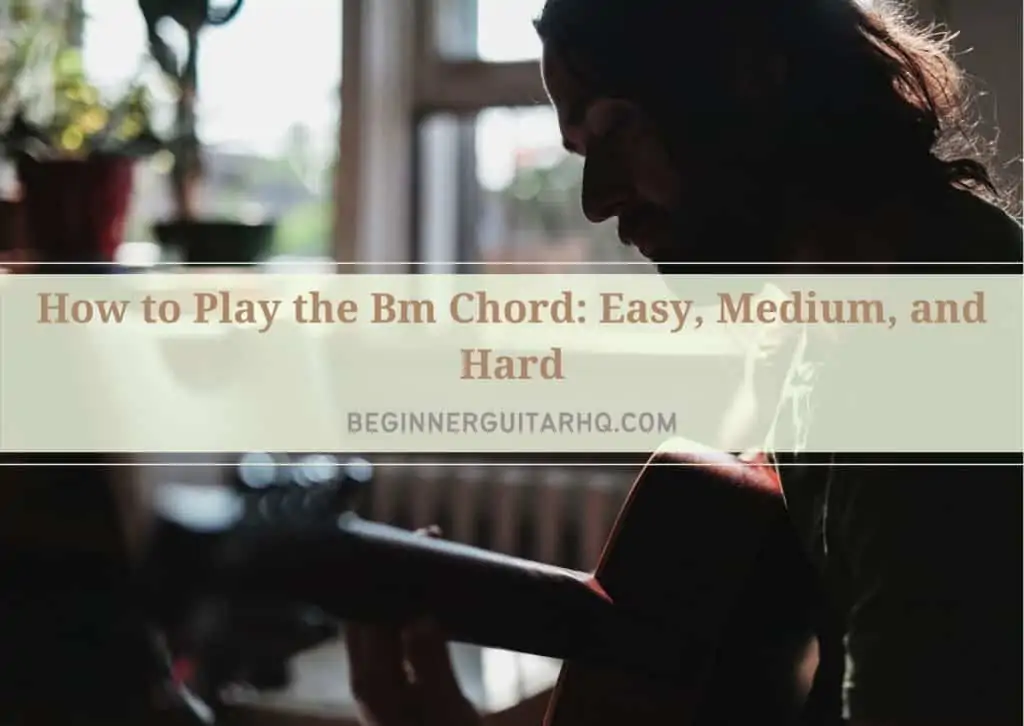The Bm chord is one of those chords that I found a little daunting in the beginning. At the time, I only knew of the open chord and the barre chord in the seventh fret. When I first learned how to play barre chords, I could play only in barre chords and only in open chords. There was no mix for me.
Since then, with regular practice, these issues have become a thing of the past. I now know quite a few other ways to play the Bm guitar chord and use whichever to suit what I feel like playing that day.
I’m going to share these chords with you. With regular practice, you’ll be able to play them well, and it will feel natural. You’ll also probably find out which version of the Bm chord is your favorite and works best for you and whatever genre or song you’re playing.
Contents
Theory of Bm Chord
Written in letters as the triad, the Bm chord looks like this: B D F#. These are the notes that you will be playing on the guitar to form the chord.
It’s a minor chord because the third interval has been flattened. B major is written as B D# F#.
Intervals are the degrees of the scale. For some perspective, this is the B major scale:
B C# D# E F# G# A#
1 2 3 4 5 6 7
This is the natural B minor scale:
B C# D E F# G A
1 2 3 4 5 6 7
I say natural scale, because there are a few types of minor scale, including the harmonic minor scale, the melodic minor scale, and the minor pentatonic. The natural minor scale reflects the actual key of B minor.
You tell what the key is by how many sharps (#) or flats (♭) there are. B minor has two sharps, F# and C#. An easy way to see this is using the circle of fifths.
How to Play the B Minor Guitar Chord: Easy
If you are just starting out or if your nerves get the better of you, using one of the easy versions works well. I still use version 1 every now and then after all these years.
Bm Version 1
This version requires only three strings to be played by both the fretting and strumming/picking hand. It doesn’t sound very full since it lacks bass, but it’s still a nice sounding chord, especially for picking. If you strum or pick the fourth string, you will get a little more depth thanks to that extra D.
How to Play Bm Version 1:
- Index finger: 1st string, 2nd fret (this gives you an F#)
- Middle finger: 2nd string, 3rd fret (this gives you a D)
- Ring finger: 3rd string, 4th fret (this gives you the B)
Bm Version 2
This version is played in the seventh fret, and you do need to stick to the bottom three strings unless you want to play a Bm7 chord. While this isn’t wrong at all and adds some flavor, if you want just a Bm chord, you should stick to just those three strings.
You can also wrap your hand around so that your thumb presses down on the B on the bassy E-string. That can add a lot of flavor by allowing you to strum or pick that B note before playing the rest of the chord.
This chord is higher pitched and has a lovely light, slightly jazzy sound that would also not be out of place in music on an island, sunny or not. While minor chords are considered sad sounding, this version sparks a lot of joy for me.
How to play Bm Version 2:
The easiest way to play this chord is simply barre those three strings in the seventh with your index finger.
This is also the best way to play it if you want to wrap your thumb around for the B on the 6th string in the same fret.
It will probably hurt a bit for the first few times you play it. But practice it regularly to build up those calluses on the bottom of your finger.
If you struggle to barre those strings, you can also play it with three fingers like you would the open A chord.
Bm Version 3
This shape is a simplified version of the E-shape barre chord in the seventh fret. It can be a little more difficult since you only play strings 1-4, but ultimately it’s quite easy to play once you get the hang of it.
How to Play Bm Version 3:
- Index finger: Barre fret 7, strings 1-3
- Ring finger: String 4, fret 9
How to Play the B Minor Guitar Chord: Medium
These versions are each a little harder in their own way, but will provide you with a fuller sound.
Bm Version 4
This chord may be easy straight off the bat for some, or a little harder for others. It can be awkward to get your fingers into this formation quickly. Not to mention that you only play strings 2-5. In my opinion, this works well with finger picking. But your hands will know where to strum with practice if you prefer to strum, with a plectrum or your fingers.
But if you enjoy the sound of it, practice it regularly, and you’ll have it down in no time.
How to Play Bm Version 4:
- Index finger: String 5, 2nd fret
- Middle finger: String 2, 3rd fret
- Ring finger: String 4, 4th fret
- Pinky finger: String 3, 4th fret
Bm Version 5
This chord is actually the first one that most students are taught. While I didn’t have formal guitar training, I learned from books. This was the only version that I knew aside from the E-shape barre chord for a long time.
The shape is a little trickier to play, but you’ll get it with consistent practice if you struggle at first. You’re adding your pinky to the version 1 shape. You get an extra F# on the D string (4th string).
How to Play Bm Version 5:
- Index finger: 1st string, 2nd fret
- Middle finger: 2nd string, 3rd fret
- Ring finger: 4th string, 4th fret
- Pinky finger: 3rd string, 4th fret
Only play those four strings.
Bm Version 6
This is a barre chord which can be tough to play in the beginning. But practicing regularly will build up the strength in your fretting hand. Barre chords, when played properly, give you a nice full sound.
Essentially, you’re using the A-shape barre chord with the root on the fifth string. But instead of the A shape with the barre across the top which gives you a major chord, you play it as the E shape.
I’ve put this under medium because this is the easier barre chord to play. It’s easier to make all the strings ring properly using this shape.
How to play Bm Version 6:
- Index finger: Barre fret two, strings 1-5. It’s okay if you barre all 6 strings and strum them too. You’ll get an F# on the 6th string.
- Middle finger: 2nd string, 3rd fret
- Ring finger: 4th string, 4th fret
- Pinky finger: 3rd string, 4th fret
Bm Version 7
This chord shape uses the Gm-shape and you can shift it up and down using the root on the sixth string. It can be a little harder to play in that you only play strings 3-6. You can, however, mute the bottom two strings with your index finger if need be.
How to Play Bm Version 7:
- Index finger: Barre strings 3 and 4 in the 4th fret
- Middle finger: 5th string, 5th fret
- Ring or pinky finger: 6th string, 7th fret
Bm Version 8
This barre chord uses the root on the 6th string and uses the Em shape. It can be tough in the beginning to get all the strings to ring out clearly. But this will sort itself out once your strength builds up, or if you have smaller hands, get the hang of positioning your fingers just right. You can bolster your index finger with your middle finger.
How to Play Bm Version 8:
- Index finger: Barre fret 7, strings 1-6
- Ring finger: 5th string, 4th fret
- Pinky finger: 4th string, 4th fret
How to Play the B Minor Guitar Chord: Hard
These shapes will take more practice to master.
Bm Version 9
This is a slightly more difficult shape to play, but it sounds beautiful. It’s a higher voicing since you only play strings 1-4, and it’s played higher up on the neck. Technically, this shape is the Dm-shape in the CAGED system. You can shift it around using the root on the 4th string.
How to Play Bm Version 9:
- Index finger: 4th string, 9th fret (root note)
- Middle finger: 1st string, 10th fret
- Ring finger: 3rd string, 11th fret
- Pinky finger: 2nd string, 12th fret
Bm Version 10
This chord can be quite tricky if you aren’t used to playing in the smaller frets at the bottom of the neck, especially if you have longer fingers. But if you’re looking for a higher pitched voicing, this Bm chord is worth learning.
How to Play Bm Version 10:
- Index finger: 3rd string, 11th fret
- Middle finger: 4th string, 12th fret
- Ring finger: 2nd string, 12th fret
- Pinky finger: 1st string, 14th fret
Conclusion
Bm is an important chord. It often comes up in the key of G and D which are popular keys. So learning to play it will definitely open access to more songs for you, especially if you don’t want to play with a capo.
If you feel a little daunted by this chord, just remember that practice will sort that right out. It may take time, but you will get there. You don’t need to learn the hardest versions unless you like the way they sound. You can stick to the easier versions as long as they suit your needs.
Enjoy practicing and when you get the hang of this chord, jamming too!

Cheanné Lombard lives in the home of one of the new Seven World Wonders, Cape Town, South Africa. She can’t go a day without listening to or making music.
Her love of music started when her grandparents gave her a guitar. It was a smaller version of the full-sized guitars fit for her little hands. Later came a keyboard and a few years after that, a beautiful dreadnought guitar and a violin too. While she is self-taught when it comes to the guitar, she had piano lessons as a child and is now taking violin lessons as an adult.
She has been playing guitar for over 15 years and enjoys a good jam session with her husband, also an avid guitarist. In fact, the way he played those jazzy, bluesy numbers that kindled the fire in her punk rock heart. Now she explores a variety of genres and plays in the church worship group too and with whoever else is up for a jam session.











